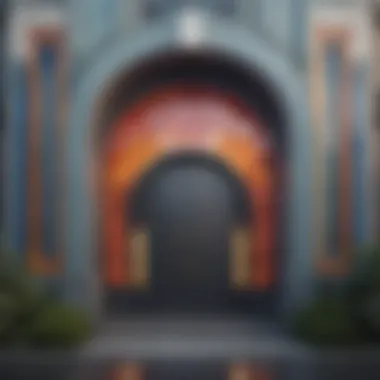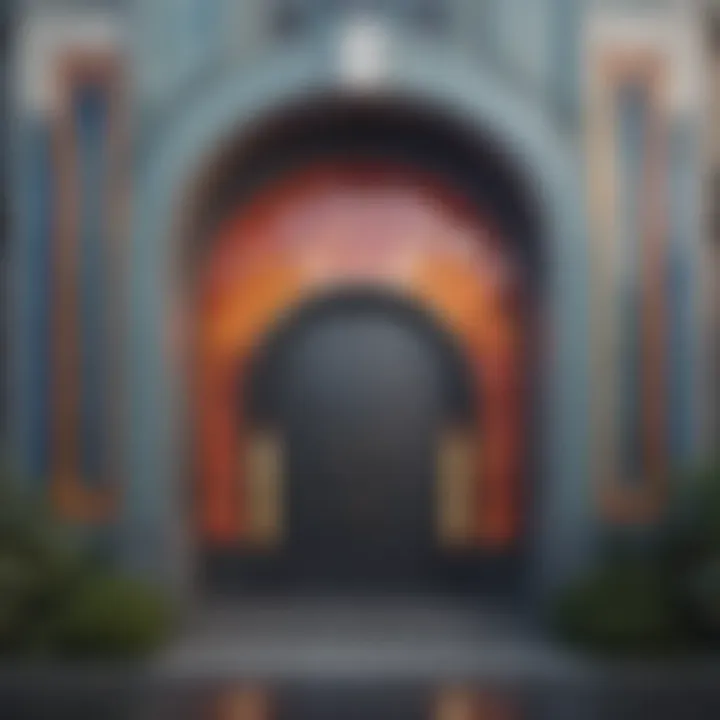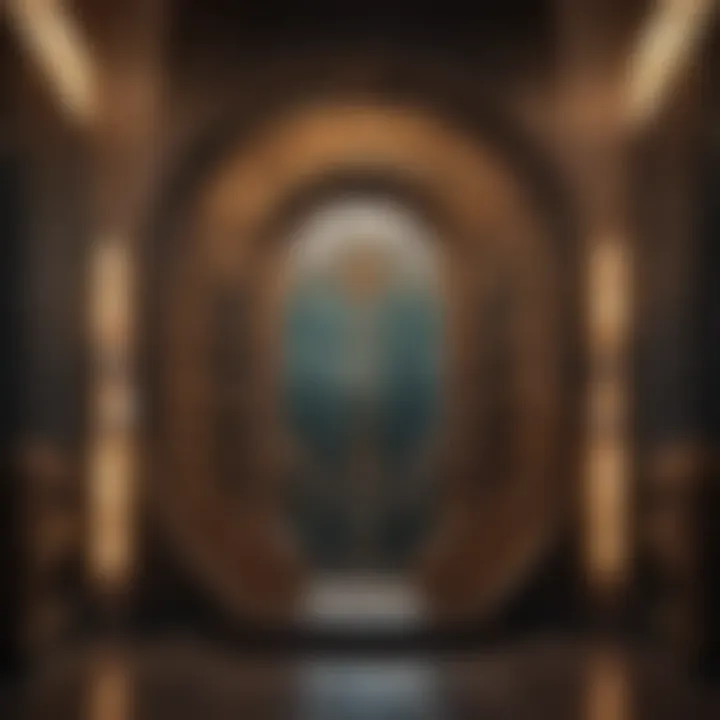Exploring the Rich Varieties of Art Deco Design


Intro
Art Deco design is a compelling and layered style that emerged early in the 20th century. This movement reflects a response to the chaos and excesses of the previous era, signifying a thirst for modernity and order. Recognized for its bold lines, geometric shapes, and intricate details, Art Deco marries form and function in remarkable ways.
This article will explore the various aspects of Art Deco, particularly focusing on architecture, furniture, and decorative arts. Understanding these elements provides insight into how Art Deco has influenced not only aesthetics but also cultural values throughout time.
Featured Homes
Architectural Highlights
Art Deco architecture is characterized by its distinctive features. This style often incorporates smooth lines, which give structures a sense of elegance. Notable buildings such as the Chrysler Building in New York and the Palais de Chaillot in Paris showcase the typical Art Deco silhouette; tall, slim, and often adorned with rich details.
Key characteristics of Art Deco architecture include:
- Use of geometric shapes: Triangles, zigzags, and chevrons are common.
- Materials: Concrete, aluminum, and glass are popular, reflecting modern technology.
- Symmetry: Buildings are often designed with a focus on balanced proportions.
These features come together to create structures that feel both timeless and progressive.
Interior Design Themes
Interior design in the Art Deco style embraces luxury and sophistication. Rich colors and materials elevate spaces, often including elements such as mirrored surfaces, polished woods, and bold fabrics. Common themes include:
- Bold patterns: Geometric patterns are a staple in textiles and wall coverings.
- Luxurious furnishings: Furniture often features inlaid wood, chrome accents, and plush upholstery.
- Decorative arts: Pieces such as sculptures, ceramics, and lighting fixtures are designed to enhance the overall aesthetic of a space.
Art Deco interiors do not just serve a practical function; they create an atmosphere of elegance and exclusivity.
The convergence of these elements creates a seamless and inviting environment, often aiming for a sense of opulence while maintaining modern sensibilities.
Location Spotlights
Cultural Significance
The cultural significance of Art Deco extends beyond aesthetics. It represents a period of change, innovation and optimism. The style influenced not just the United States and Europe, but also had a global reach, impacting countries as far as India and Brazil. Understanding this context allows us to appreciate Art Deco's role in shaping urban identity during a time of significant social transformation.
Natural Wonders
While less directly related to Art Deco, the integration of the natural world can be observed in various designs, particularly in landscaping and decorative elements. Art Deco often incorporates motifs from nature such as flora and fauna, blending them with geometric designs to create harmonious environments.
In synthesis, exploring the different facets of Art Deco design reveals a rich tapestry of influence and creativity. As we uncover the nuances of this remarkable style, we can appreciate not only its visual appeal but also its deeper cultural implications.
Preface to Art Deco
Art Deco stands as a defining ornament of early 20th-century aesthetic culture. Its influence permeates architecture, interior design, and decorative arts, making understanding this design movement essential for those who appreciate its beauty and historical significance. Exploring Art Deco enables us to connect with the societal transformations and artistic movements that shaped its evolution.
This section introduces readers to the origins and context from which Art Deco emerged. Recognizing these foundations is crucial in grasping how the movement reflects broader cultural shifts and technological advancements of the time.
The Origins of Art Deco
Art Deco's roots trace back to the 1920s in France. The movement gained momentum following World War I, a time when people sought to break from the past and embrace modernity. Major exhibitions, like the Exposition Internationale des Arts Décoratifs et Industriels Modernes held in Paris in 1925, played a pivotal role in the formal recognition of the style.
This new approach to design prioritized geometry, clean lines, and ornamentation, emblematic of a society eager for elegance and progression. This was a departure from the ornate and intricate styles of previous eras. Furthermore, the increased availability of new materials and manufacturing techniques allowed designers to push creative boundaries in ways that had not been seen before.
Art Deco and Its Historical Context
Understanding the historical context of Art Deco enriches one's appreciation of its design philosophy. The movement emerged during a period marked by significant social changes and technological innovations. The aftermath of World War I prompted a desire to reinvent societal norms, leading to a creative flourishing.
Art Deco is not merely an aesthetic choice; it embodies the spirit of modernization, industrialization, and the excitement of the Roaring Twenties. The style reflects a blend of influences from various cultures, including African, Aztec, and Asian art, showcasing its global reach.
Art Deco's historical context reveals its relationship with advancements in technology, including the rise of cinema, automobiles, and skyscrapers, all of which are essential icons of modern life.


"Art Deco is the response to the challenge of how to imbue modernity with a sense of beauty and elegance."
In summary, Art Deco represents more than a mere design choice; it is a cultural artifact that speaks to a significant period in human history. By examining its origins and historical context, one gains a comprehensive understanding of its lasting impact and relevance.
Key Characteristics of Art Deco
Understanding the key characteristics of Art Deco is essential. This distinctive style has shaped both aesthetic ideals and cultural values since its emergence in the early 20th century. Recognizing its features helps to appreciate its significance in not just art, but design of various forms. Art Deco brings together streamlined forms, vivid colors, and luxurious materials, which contribute to a visual language that conveys modernity and sophistication.
Geometric Forms and Lines
One hallmark of Art Deco is its use of geometric forms and bold lines. These elements create a sense of symmetry and order, often depicted in architecture and furniture. The style emphasizes angular shapes, zigzags, and straight lines. Such designs reflect the technological advancements of the era, showcasing a newfound love for industry and modernity.
In architecture, skyscrapers demonstrate these geometric principles, turning the cityscape into an expression of power and progress. Furniture pieces often feature sharp angles and clean lines, contrasting earlier stylistic periods that embraced curves and ornamentation. The adherence to geometry serves more than an aesthetic purpose; it encapsulates a cultural shift toward functionality without abandoning elegance.
Rich Colors and Ornamentation
Next, the vibrant color palettes and ornate details characteristic of Art Deco are noteworthy. Rich hues like emerald green, deep blue, and gold accents dominate the color schemes. These colors create a luxurious atmosphere that reflects the opulence of the era.
Ornamentation in Art Deco goes beyond mere decoration. It often includes motifs that derive from various influences, such as Egyptian, Aztec, and even Cubist art. Decorative elements can be found in architectural friezes, furniture designs, and textile patterns. This blend of influences creates a unique brand of ornamentation that is both eye-catching and culturally diverse. Not only does it serve to beautify, but it also narrates the history and shared values of society during that time.
Materials Used in Art Deco
Art Deco utilizes a range of materials that were revolutionary at the time. These include metals like aluminum and chrome, as well as luxurious options like marble and glass. The combination of different textures invites tactile engagement, enriching the overall experience.
Metals symbolize the industrial prowess of the early 20th century while also evoking a sense of modern chic. Glass, often used in lighting fixtures and decorative elements, plays with light and space, further enhancing the ambiance of a room. Furthermore, craftsmanship is vital in Art Deco, where skilled artisans pay attention to detail in both functional and decorative objects.
In summary, the characteristics of Art Deco create a distinct visual and cultural identity. The geometric forms, rich colors, and diverse materials all contribute to this timeless design language. Understanding these elements enriches our appreciation not just for the style itself, but also for the broader cultural forces that shaped its conception and evolution.
Types of Art Deco Architecture
The significance of Art Deco architecture lies in its ability to blend functionality with bold aesthetics. This architectural style emerged during a time of rapid urbanization and technological advancement. It reflects a departure from the ornate styles of the past, favoring clean lines and geometric patterns. Art Deco architecture captures both cultural movements and societal aspirations of the early 20th century. The relevance of this topic is paramount as it showcases how artistic expression can shape urban landscapes, influence community identity, and elevate the visual appeal of environments.
Skyscrapers and Urban Buildings
Art Deco skyscrapers represent a pinnacle of this design movement. Cities like New York and Chicago embraced this style, resulting in iconic structures such as the Chrysler Building and the Empire State Building. These buildings feature streamlined silhouettes, striking ornamentation, and towering heights that redefine urban skylines. Their use of imagery often combines modern technology with classical elements, such as zigzags and chevrons.
The materials used, including steel and glass, reflect advancements in engineering and construction. A key benefit of these skyscrapers is their role in symbolizing economic prosperity during the 1920s and 1930s. They also serve as landmarks that draw tourists and locals alike, contributing to the cultural tapestry of cities.
Residential Architecture
Art Deco found its way into residential designs, offering homeowners a unique aesthetic that merged comfort with elegance. Characterized by features such as rounded corners, bold roofing styles, and decorative details on facades, these homes are a testament to the style's versatility. Many Art Deco homes include curved windows and geometric patterns in their designs, evoking a sense of harmony and cohesion.
In suburban settings, this style created neighborhoods that were distinct from traditional styles. The appeal of Art Deco residential architecture lies in its ability to convey luxury while still accommodating daily living needs. Homeowners are drawn to the uniqueness of this style, which stands out in a sea of common housing designs.
Public Buildings and Institutions
Public buildings designed in the Art Deco style often serve as hubs of social and cultural activity. Examples include schools, libraries, and government buildings. These structures are marked by grand entrances, expansive staircases, and intricate decorative elements that convey authority and sophistication. The designs often incorporate local materials and motifs, reflecting the community’s identity.
The influence of Art Deco in public architecture promotes functionality without sacrificing aesthetic impact. Such buildings enhance their surroundings, inviting admiration from the public. They serve to reaffirm the importance of architecture in public life, reminding us of the power of design to inspire and unite communities.
Art Deco architecture is not simply a style; it is a narrative of aspiration, progress, and cultural dialogue.
Art Deco in Interior Design
Art Deco in interior design is an integral aspect of this aesthetic movement, marking a shift towards modernity in home spaces during the early 20th century. This style reflects luxury, sophistication, and a keen sense of design that combines both function and aesthetics. The elements of Art Deco, including its furniture, textiles, and lighting, contribute significantly to creating spaces that feel both elegant and inviting. This section will explore these components and their relevance within the greater context of Art Deco, particularly for those who appreciate historical design and its contemporary applications.
Furniture Styles
Furniture styles in Art Deco are a testament to the opulence of the period. Characterized by bold lines, geometric shapes, and luxurious materials, Art Deco furniture redefined how personal and public spaces were utilized. The use of exotic woods, chrome, glass, and leather enhanced the aesthetic appeal of furnishings during this era. Notable pieces often include:
- Streamlined sofas with sharp angles
- Articulated coffee tables made of glass and polished metal
- Cabinets and dressers featuring intricate marquetry and metallic inlays


These styles exhibit a departure from the ornate excesses of previous eras and embraced a more functional yet luxurious approach. The use of color was also significant; richer hues paired with gold accents created a lavish atmosphere suitable for both homes and public spaces.
Textiles and Patterns
Textiles and patterns play a crucial role in enhancing the aesthetic beauty of Art Deco interiors. Fabrics in this style commonly feature bold, geometric patterns that echo the overall design philosophy of the movement. Common materials used include:
- Silks and velvets for their luxurious feel
- Cottons and linens with striking patterns or prints
Patterns often include chevrons, zigzags, and sweeping curves that resonate with the overall Art Deco design ethos. Wall coverings, drapes, and upholstery often display a mix of these graphic designs. The blending of texture and pattern creates depth and richness in a room, highlighting the distinct Art Deco look that appeals to design aficionados today.
Lighting Fixtures
Lighting fixtures are another hallmark of Art Deco interior design. These fixtures not only illuminate spaces but also serve as artistic statements. Influenced by technological advancements and modern materials, Art Deco lighting offers a unique combination of functionality and style. Common features found in Art Deco lighting include:
- Sconces and chandeliers that showcase sharp angles and geometric forms
- Lamps often made from metals like bronze paired with glass shades
- Colorful stained glass that evokes the vibrant spirit of the 1920s
These fixtures often serve dual purposes: to provide light and to act as captivating focal points in a room. The thoughtful integration of lighting enhances the overall ambiance, reinforcing the luxurious feel that Art Deco is known for.
"Art Deco is about embracing change, and using materials and techniques that were newly available; it is a celebration of the modern age."
Art Deco in Decorative Arts
Art Deco played a vital role in the decorative arts, extending the movement's influence beyond architecture and furniture onto a wide range of objects and materials. This style, distinguished by its elegant geometrical forms, vibrant colors, and luxurious materials, reflects the spirit of modernity and innovation in the early 20th century. The incorporation of Art Deco into decorative arts has not only enriched aesthetic experiences but also offered insights into cultural sentiments during the period. Understanding this facet of Art Deco allows one to appreciate how it transformed everyday items into artistic statements, thus enhancing the surroundings and personal expression.
Ceramics and Glassware
Ceramics and glassware emerged as key components of the Art Deco movement. Designers created pieces that were not only functional but also celebrated artistic expression. Ceramics produced during this period often featured bold, striking designs while showcasing vibrant colors and intricate patterns. Notable examples include vases, plates, and figurines from makers such as Clarice Cliff and Royal Doulton. The use of geometric patterns and stylized motifs highlighted the essence of Art Deco.
Glassware, too, flourished with brands like Lalique and René Lalique pioneering designs. The emphasis was on craftsmanship, clarity, and the use of light, which gave glass objects a unique, luminous quality. Decorative glass pieces often showcased etched surfaces and elaborate shapes, merging functionality with art.
- Benefits of Ceramics and Glassware in Art Deco:
- Enhances interior spaces with bold and unique elements.
- Offers a distinct touch to personal collections.
- Highlights skilled craftsmanship and design innovation.
Metalworks and Jewelry
The Art Deco style also revolutionized metalworks and jewelry. Using materials like gold, silver, and platinum, artisans crafted innovative designs that catered to modern tastes. Jewelry pieces became bold and non-traditional, often combining colorful gemstones with contrasting materials, producing pieces that were striking and based on geometric forms. Houses such as Cartier and Van Cleef & Arpels exemplified the Art Deco era's influence on jewelry design.
Metalwork was evident in a variety of applications including furniture, fixtures, and decorative items. The use of sleek lines and repeating geometric patterns emphasized modern aesthetics, merging functionality with style. Metal sculptures and furniture showed how practicality and art could coexist seamlessly in design.
- Considerations in Metalworks and Jewelry:
- The rarity of original pieces increase their value.
- Influence of designs still present in modern jewelry trends.
- Collecting Art Deco metalworks requires deep knowledge and appreciation of craftsmanship.
Wall Art and Murals
Wall art and murals offered a bold canvas for expressing the Art Deco lifestyle. Murals ornamented public and private spaces, depicting themes such as industry, modernity, and human achievements. Artists like Tamara de Lempicka were prominent figures, using oil paint and fresco techniques to create stunning visuals.
Wall art during this period was characterized by its strong motifs and vibrant coloring. The use of materials like plaster, metal, and glass combined with the boldness of geometric shapes conveyed a sense of dynamism and progress, fitting perfectly within the context of an evolving society.
- Key aspects of Art Deco Wall Art and Murals:
- Captivating narratives through art that reflect societal themes.
- Use of modern materials alongside traditional ones.
- Ability to transform spaces and elevate the atmosphere.
In summary, the decorative arts within the Art Deco movement symbolize a critical moment in design history. They encapsulate a blending of function with artistic expression, making everyday objects stand out as creative masterpieces.
Regional Variations of Art Deco
Art Deco is not merely a single style; it is a vibrant genre that manifested uniquely across different regions. These regional variations are crucial to understanding how Art Deco evolved and adapted to various cultural contexts. Each geographical area contributed its own cultural, historical, and artistic influences, resulting in distinct forms and expressions of Art Deco design. This section will explore these variations, focusing on American Art Deco, French Art Deco, and other global interpretations. By examining these differences, we can appreciate the versatility and enduring legacy of Art Deco on a global scale.
American Art Deco


American Art Deco emerged in the 1920s, characterized by bold geometric shapes and a sense of optimism and modernity. Influenced by the skyscraper boom, this form of Art Deco often showcased intricate detailing, especially in urban architecture. Buildings like the Chrysler Building in New York exemplify how American designers embraced height and grandeur.
Key characteristics of American Art Deco include:
- Use of materials: Chrome, glass, and polished stone were prevalent. They highlighted luxury and sophistication.
- Decorative motifs: Common designs include zigzags, chevrons, and streamlined forms, emphasizing speed and modernization.
- Functionality: Buildings often served practical purposes, but aesthetics remained essential.
American Art Deco also found expression in interior design. From furniture featuring smooth lines to vibrant fabrics, the style reflected the country's progressive spirit during the early 20th century.
French Art Deco
French Art Deco is often considered the highest expression of the style, merging elegance and opulence. Rooted in the decorative arts, this variation manifests in various forms, including architecture, furniture, and textiles.
Key elements of French Art Deco include:
- Artistic craftsmanship: Emphasis on luxurious materials, fine craftsmanship, and artistic collaboration among designers.
- Inspiration from history: French designers drew from classical and Baroque influences, creating a blend of modernism and tradition.
- Sophisticated elegance: French Art Deco embraces ornamentation and intricate details more than its American counterpart.
Notable examples include the Palais de Tokyo and the Théâtre des Champs-Élysées in Paris, where the designer's vision harmonizes with artistic expression, creating spaces of extraordinary beauty.
Other Global Interpretations
Beyond North America and France, Art Deco found unique expressions in various parts of the world. Each region adapted the style to fit local materials, aesthetics, and cultural narratives.
For instance:
- Latin America: Here, Art Deco incorporated vibrant colors and local motifs, particularly in Brazil. The Copan Building in São Paulo is a prime example, showcasing organic shapes distinct from its American or French counterparts.
- Asia: In countries like India and China, Art Deco was blended with traditional architectural styles. The Marine Drive in Mumbai displays Art Deco’s adaptation to local contexts.
- Australia: This region adopted Art Deco to reflect its own cultural identity, with influences from the natural environment, seen in structures like the Wilson's Wharf in Brisbane.
"Art Deco’s ability to absorb influences from varied cultures showcases its versatility and global appeal."
Understanding the unique characteristics across regions enriches the appreciation for Art Deco as a truly global phenomenon.
The Revival of Art Deco
The revival of Art Deco represents a fascinating chapter in the ongoing dialogue between past and present. This resurgence encapsulates not only a resurgence in aesthetic appreciation but also a renewed interest in the cultural values associated with this storied design style. Many designers and architects are looking back at the bold forms, rich colors, and luxurious materials characteristic of Art Deco as a source of inspiration. This trend signifies a broad acknowledgment of the significance of Art Deco in shaping modern design sensibilities.
Contemporary Applications
In various domains, the influence of Art Deco is vividly palpable today. In architecture, many modern buildings reflect the geometric symmetry and streamlined forms that define the style. Urban dwellers often encounter new constructions that incorporate Art Deco-inspired elements, such as intricate tile work or decorative metal grilles. For instance, the use of bold, angular shapes in items such as faucets or light fixtures is becoming increasingly prevalent in contemporary interior design.
Moreover, furniture design is experiencing a similar revival. Designers are integrating rich woods, glossy finishes, and bold patterns reminiscent of the Art Deco era into their pieces. This blend of old and new allows for a fresh take on classic styles, engaging clients who appreciate historical craftsmanship yet desire modern function.
"Art Deco is not just a style; it’s an era that continues to inspire and innovate."
Influence on Modern Design
The ongoing resurgence of Art Deco affects how we perceive modern design. This intersection of historical reference and avant-garde thinking encourages designers to experiment with form and materials, effectively blending traditional methods with contemporary approaches. Artists are increasingly exploring metallic finishes, angular silhouettes, and ornamental details—hallmarks of Art Deco—among their palettes.
In the realms of graphic design and fashion, we can see these influences as well. Graphic designers utilize Art Deco patterns for branding, creating visual identities that are both striking and elegant. Fashion houses also draw from the rich textile patterns of the 1920s and 30s, marrying them with modern cuts and silhouettes, thus preserving the vibrancy of the era while connecting with new markets.
As a result, the revival of Art Deco not only showcases the beauty of this unique style, it also drives innovation in design thinking. This is a crucial moment for designers across various fields—one that carries the weight of history while paving new avenues for artistry. This equilibrium fosters a landscape where the past enhances the present, offering various narratives about cultural and aesthetic evolution.
Epilogue
The examination of Art Deco's lasting impact is paramount in understanding its role in the broader scope of design history. This article explores how Art Deco has transcended time, continually influencing various design fields, from architecture to interior decor, and decorative arts. It invites readers to reflect on the intricacies of this unique style and its relevance today.
Art Deco's Lasting Legacy
Art Deco emerged during a period of great change and innovation. Its aesthetic encapsulates the spirit of an era marked by industrial advancement and cultural exploration. The legacy of Art Deco is visible not only in historic structures but also in modern designs.
- Cultural Influence: Art Deco's visual language encourages a sense of elegance and modernity. This can be seen in major cities worldwide, where buildings and interiors still reflect Deco's geometric and ornamental features.
- Sustainable Elements: Today, decorators and architects draw inspiration from Art Deco’s principles. The use of rich materials and decorative forms brings a luxurious feeling to spaces, making them timeless yet contemporary.
- Preservation of Heritage: As cities grow, the preservation of Art Deco buildings stands as a testament to this style's enduring appeal. Organizations and communities actively work to maintain these structures, acknowledging their historical significance and aesthetic value.
Art Deco's rich diversity emphasizes a balance between form and function. This balance is not merely aesthetic but underscores the effectiveness of good design. In our modern context, the emphasis on luxury, craftsmanship, and uniqueness fosters a renewed appreciation for Art Deco.
The journey of understanding Art Deco leads us to appreciate its many layers. Its influence on contemporary design shows that while styles may evolve, the core principles of Art Deco remain relevant and cherished.
"Art Deco has shaped cultural and aesthetic values over time, leaving behind an undeniable legacy that evokes both nostalgia and inspiration for future generations."
Thus, the exploration of Art Deco is not merely an academic exercise. It is a recognition of its enduring impact on how we perceive beauty and functionality in our spaces today.







